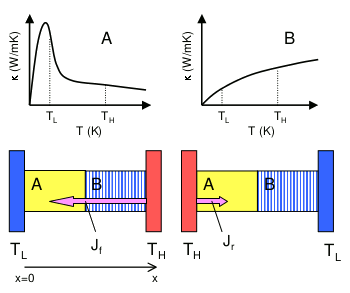
Thermal Diodes
February 19, 2014 The simplest semiconductor device is the diode. Transistors are the crowning achievement of solid state electronics, but diodes have been very useful devices. Used as rectifiers, semiconductor diodes function as miniature replacements for vacuum tubes in power supplies. In the early days of computing, they were ubiquitous in circuitry known as diode-transistor logic, DTL (see figure). | Portion of a circa 1967 circuit board from a Univac computer. The many diodes are part of a diode-transistor logic (DTL) circuit. (Photograph by the author.) |
 | Semiconductor diode P-N junction and symbol. (Illustration by the author, rendered using Inkscape.) |
 | Thermal conductivity effect thermal diode. A junction between materials with opposite temperature coefficients of thermal conductivity produces the thermal diode effect. (Fig. 1 of ref. 5, via arXiv.[5]) |
 | Purdue University thermal rectifier concept. Small, triangular graphene nanoribbons will transfer more heat in one direction than the other, and the triangles can be linked to produce a greater effect. (Reformatted Purdue University image.) |
"Asymmetric materials, such as asymmetric nanowires, thin films, and quantum dots of a single material can also be high-performance thermal rectifiers, as long as you have lateral confinement... This really broadens the potential of this rectification to a much wider spectrum of applications."[8]One application could be a "thermal transistor" that used phonons instead of electrons for operation.[8]. Another might be building insulation. Says Ruan,
"For example, on a winter night you don't want a building to lose heat quickly to the outside, while during the day you want the building to be warmed up by the sun, so it would be good to have building materials that permit the flow of heat in one direction, but not the other."[8]The research was funded by the U.S. Air Force Office of Scientific Research.[8]
References:
- The PN Junction - How Diodes Work (English version), YouTube video, Teaching Innovation Project 11-293 of Universidad de Granada (Spain), May 4, 2013.
- Catalin Chiritescu, David G. Cahill, Ngoc Nguyen, David Johnson, Arun Bodapati, Pawel Keblinski and Paul Zschack, "Ultralow Thermal Conductivity in Disordered, Layered WSe2 Crystals," Science, vol. 315, no. 5810 (January 19, 2007), pp. 351-353.
- R. M. Costescu, D. G. Cahill, F. H. Fabreguette, Z. A. Sechrist and S. M. George, "Ultra-Low Thermal Conductivity in W/Al2O3 Nanolaminates," Science, vol. 303, no. 5660 (February 13, 2004), pp. 989-990.
- G. Pernot, M. Stoffel, I. Savic, F. Pezzoli, P. Chen, G. Savelli, A. Jacquot, J. Schumann, U. Denker, I. Mönch, Ch. Deneke, O. G. Schmidt, J. M. Rampnoux, S. Wang, M. Plissonnier, A. Rastelli, S. Dilhaire and N. Mingo, "Precise control of thermal conductivity at the nanoscale through individual phonon-scattering barriers," Nature Materials, vol. 9, no. 6 (June, 2010), pp. 491-495.
- W. Kobayashi, Y. Teraoka and I. Terasaki, "An oxide thermal rectifier," Applied Physics Letters, vol. 95, no. 17 (October, 2009), Document No. 171905 (3 pages); available, also, on arXiv.
- Heat Diode Paves the Way For Thermal Computing, Technology Review, October 9, 2009.
- Yan Wang, Ajit Vallabhaneni, Jiuning Hu, Bo Qiu, Yong P. Chen and Xiulin Ruan, "Phonon Lateral Confinement Enables Thermal Rectification in Asymmetric Single-Material Nanostructures," Nano Letters, Article ASAP (January 6, 2014), DOI: 10.1021/nl403773f.
- Emil Venere, "Research could bring new devices that control heat flow," Purdue University Press Release, January 27, 2014.
- Catalin Chiritescu, David G. Cahill, Ngoc Nguyen, David Johnson, Arun Bodapati, Pawel Keblinski and Paul Zschack, "Ultralow Thermal Conductivity in Disordered, Layered WSe2 Crystals," Science, vol. 315, no. 5810 (January 19, 2007), pp. 351-353.